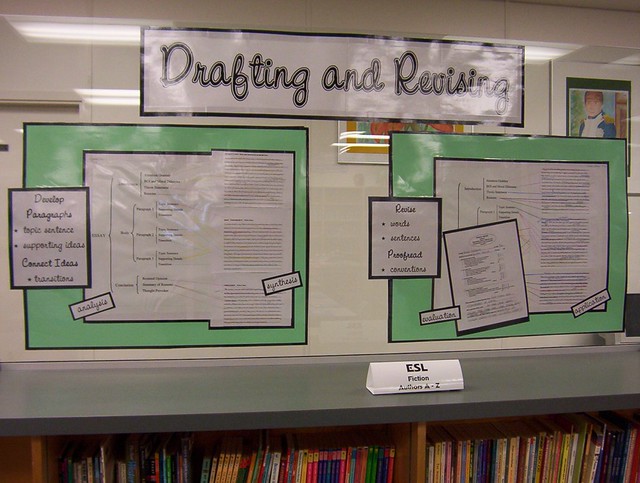 |
| Enokson. "Writing Assignment-Drafting and Revising". 2/24/10 via Flickr. Attribution 2.0 Generic License. |
The text's rhetorical situation might include...
- Context article was written under: New York state government contemplating whether or not to ban use of hydraulic fracking to extract oil; responses to author's previous encounters with controversy
- Intended audience: educated audience interested in topic/similar topics with some current background information on controversy
- Purpose of article: encourage readers to think about controversy and how to resolve it
- Cultural setting: happening in America--average American families forced involvement (part of why it is a controversial topic)
- Values/ideals: more modern values of environmental health, safety of citizens, family values
- Author's background: highly educated, experienced, and well known New York Times author
The text's rhetorical strategies might include...
- ethos
- pathos
- logos
Project 2 Outline
Introduction: I plan on beginning my essay by introducing the author and article I'm analyzing. His point of view on the controversy will be left out until the body because that wasn't a central point of why he wrote the piece. The other two points of view will be presented in this paragraph. I think the author effectively used ethos and pathos to address the cultural setting and get his central message across.
Thesis: I am using the second thesis I wrote in the previous blog post.
Develop An Analytical Claim: My claim is that the author used his credibility as a well respected New York Times writer to appeal to his logical audience's character and emotion by presenting counterarguments more than his own argument. This encouraged his readers to think about how others feel, because that's exactly what he was doing when he wrote the article.
Support The Analytical Claim: I plan on using a lot of evidence from the text itself to support my claim. There are several quotes and little things the author did which I know I can mention to offer support. The rhetorical strategies like hyperlinking other pieces of his (for credibility) and the inclusion of personal stories in favor of the argument different from his own (for emotional appeal) are just a few examples.
Body: I plan on digging a lot into the 2 different arguments presented for the first two body portions. The final body portion will be on the author's personal opinion and how he didn't really mention it, but subtly brought it up.
Conclusion: I will conclude my essay by discussing how this strategy was effective, but then ending it off with rhetorical questions asking my own audience if they would have done the same thing as the author of the text I'm analyzing. I want to involve and speak directly to my readers in the conclusion, but I'm not sure exactly how I will be doing that yet.
Reflection
After reading Stef's and Grace's blog posts, I honestly got kind of nervous about mine. It's not because it looks any different, I actually had a lot of similarities with them. The main thing for me is that I don't feel like I'm super confident with what I want to say and they seem like they are. I guess it's all a part of the writing process though...
Even though you're unsure of addressing the audience in your conclusion it's still admirable that you're steering the essay back to the rhetorical situation the rubric . Overall though I think you're outline is solid
ReplyDeleteI think you are especially solid in your support of your analytical claim. Even though you are a little unsure, as long as you pick a side and stick to it in your draft you'll be fine! This is what planning is all about!
ReplyDeleteYour outline looked very similar to mine. Some people that I read had very specific content in their outlines, whereas I had more general ideas of what I wanted to do, and not specifics of what I would say. The only suggestion I have for you is including the effective use of ethos as your thesis, and not as your introduction. Otherwise, it looks like your on the right track going forwards!
ReplyDeleteEven though you don't feel confident, I feel like you are going in the right direction. Maybe just set aside some extra time while you write your draft so that you can feel more into your topic. I think this assignment was hard for me because I overthought it. I spent a lot of time on this. I think that maybe if you just added some specific detail to this, then everything would fall into place more easily. A lot of this was very broad so you might feel lost because of that.
ReplyDelete